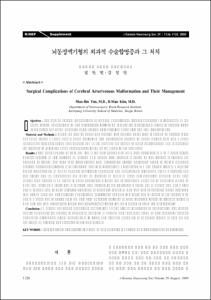KUMEL Repository
1. Journal Papers (연구논문)
1. School of Medicine (의과대학)
Dept. of Neurosurgery (신경외과학)
뇌동정맥기형의 외과적 수술합병증과 그 처치
- Alternative Author(s)
- Yim, Man Bin; Kim, El
- Journal Title
- 대한신경외과학회지
- ISSN
- 1225-8245
- Issued Date
- 2000
- Abstract
- Objectives:The goal of surgical management of cerebral arteriovenous malformation(AVM) is elimination of the lesion without development of new neurological deficits. To improve the management results of cerebral AVMs in the future, this article discusses about surgical complications of the AVM and their management.
Material and Methods:During the past 18 years, 116 patients with cerebral AVMs were managed by surgery. Among these cases, 7 cases died, 7 cases developed new neurological deficits, 11 cases residual AVM and 5 cases intracerebral hematoma(ICH) after surgery. The author analyzes the causes of those complications and investigates the methods to minimized those complications based on the review of the literatures.
Results:One stage removal of AVM and ICH in the poor neurological state were performed in 5 of 7 death cases. Subtotal removal of ICH followed by delayed AVM surgery after recovery is regard as one method to improve the outcome of patient with large ICH. Postoperative new neurological deficits developed owing to normal perfusion pressure breakthrough(NPPB) in 3, judgement error in 2, preoperative embolization in 1 and cortical injury in 1 case(s). Proper management of NPPB, accurate anatomical knowledge and physiological monitoring during operation, and well trained skill for embolization are regard as methods to minimize those complications. Residual AVMs after surgery were noticed in 11 cases, in which unintended 6 cases due to inaccurate dissection of peripheral margin of AVM, and intended 3 cases due to massive brain swelling during operation, 1 cases due to diffuse type and 1 case due to multiple type of AVM. Accurate dissection of peripheral margin of AVM and mild hypotension during operation may help to avoid this complication. Postoperative hemorrhage occurred in 3 cases due to rupture of the residual AVM and in 2 cases due to oozing from the AVM bed. Complete resection of AVM, complete control of bleeding points at AVM bed and mild hypotension during early postoperative period are the methods to avoid this complication.
Conclusion:A precise but flexible therapeutic strategy and refined skill for endovascular, radiosurgical and microsurgical techniques are required to successful treatment of cerebral AVM. Adequate timing of AVM resection, accurate anatomical knowledge, proper management of NPPB and accurate dissection of peripheral margin of AVM are the key points for avoiding complications of the AVM surgery.
- Alternative Title
- Surgical Complications of Cerebral Arterivenous Malformation and Their Management
- Publisher
- School of Medicine
- Citation
- 임만빈 et al. (2000). 뇌동정맥기형의 외과적 수술합병증과 그 처치. 대한신경외과학회지, 29(8), 1126–1135.
- Type
- Article
- ISSN
- 1225-8245
- Appears in Collections:
- 3. Research Institutues (연구소) > Brain Research Institute (뇌연구소)
1. School of Medicine (의과대학) > Dept. of Neurosurgery (신경외과학)
- 파일 목록
-
-
Download
 oak-bbb-1936.pdf
기타 데이터 / 11.48 MB / Adobe PDF
oak-bbb-1936.pdf
기타 데이터 / 11.48 MB / Adobe PDF
-
Items in Repository are protected by copyright, with all rights reserved, unless otherwise indicated.